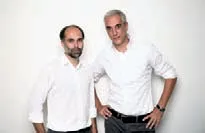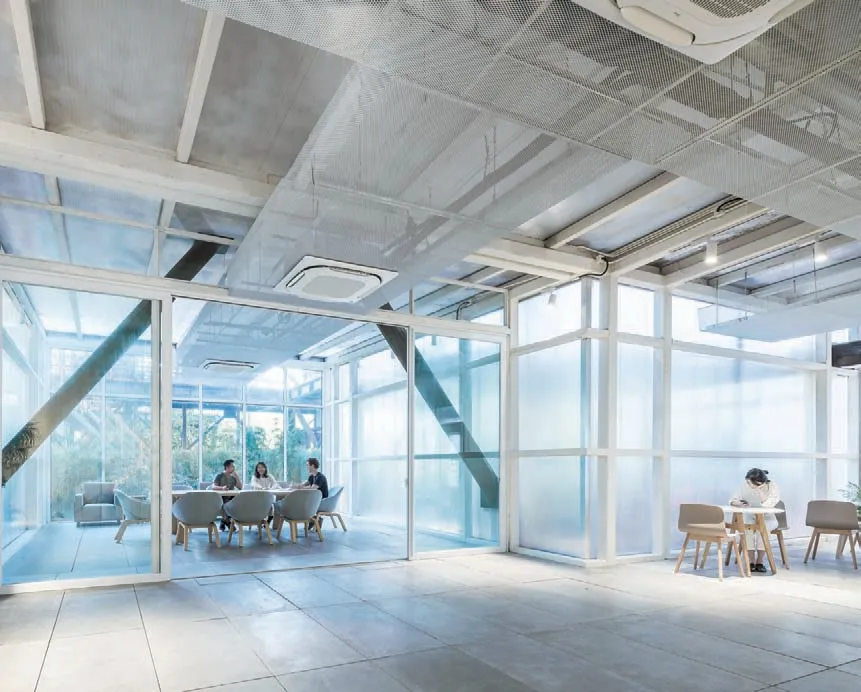灵性工业朋克
—— 宝山再生能源利用中心概念展示馆
2020-12-08AndreaDestefanis,FilippoGabbiani,陆恬等


Kokaistudios
一家涵盖建筑及室内设计的事务所,在业界屡获殊荣,由意大利建筑师Filippo Gabbiani和Andrea Destefanis 于2000 年联合创立于威尼斯。
自2002 年公司总部设于上海以来,Kokaistudios 已拥有60 余位杰出设计师,并成长为一家多元文化背景的设计公司,与客户协同合作,完成了涵盖亚洲、中东、欧洲及北美洲的众多创新设计项目。
Kokaistudios 专注于发展文化、商业、酒店及零售等方面的项目,更广泛涉及城市更新与文化遗产再造的项目,旨在为项目所在的城市增添蓬勃生机。
Kokaistudios
It is an award winning architecture and interior design firm founded in 2000 in Venice by Italian architects Filippo Gabbiani & Andrea Destefanis.
Headquartered in Shanghai since 2002 we have grown into multi-cultural firm of 60 people working on a global scale with projects in Asia, the Middle East, Europe and North America. Kokaistudios partners with our clients to collaboratively develop innovative & ground breaking projects in diverse fields of design.
Primarily focused on developing cultural, corporate, commercial, hospitality & retail projects we have also worked extensively on urban regeneration projects involving the requalification of heritage locations.
Kokaistudios aims to develop projects that add positively to the built environment and social fabric of the cities and countries in which they are located.

Andrea Destefanis
出生于意大利都灵,早年间即对视觉艺术和舞台布景有浓厚的兴趣。完成了威尼斯建筑大学的学业后,Andrea 开始了同多个建筑事务所合作的职业生涯,参与了很多获奖的建筑和城市规划项目。受其对设计中不同领域的兴趣驱动,Andrea 成立了合作工作室,致力于研究计算机平面设计的创新方法。2000 年他与Filippo Gabbiani 共同成立了Kokaistudios 设计事务所。
ANDREA DESTEFANIS
Born in Turin, Italy, Andrea Destefanis developed very early a strong interest for visual arts and scenography. After graduating from University of Architecture Venice, he started to cooperate with several architectural firms and developed award winning projects in architecture and city planning. Moved by his personal interest in different fields of design he founded a cooperative studio focused on research of innovative instrument of design in computer graphics before co-founding Kokaistudios together with Filippo Gabbiani.
Filippo Gabbiani
出生于意大利威尼斯,自幼展现出对艺术和设计的多重兴趣。在完成了威尼斯建筑大学的学业后,出于其对不同学科和多元文化的好奇心,Filippo 先后闯荡于欧洲数国及美国,曾与多家世界顶级的建筑、室内及工业设计事务所合作。2000 年他与Andrea Destefanis 共同成立了Kokaistudios 设计事务所。
地点:中国上海
建筑面积:725 m2
地块面积:3100 m2
完成时间:2020.7
客户:上海上实宝金刚环境资源科技有限公司
服务范围:建筑改造+景观设计
首席设计师:Andrea Destefanis, Filippo Gabbiani
设计总监:李伟
建筑设计经理:Andrea Antonucci
设计团队:陆恬、曲昊
摄影:张虔希
撰文:FrancesArnold
媒体负责:JacquelineChiang
FILIPPO GABBIANI
Born in Venice, Italy, Filippo Gabbiani developed very early a multidisciplinary interest for art and design. Upon graduating from the University of Architecture Venice, he began work on a European Community sponsored research project on the usage of alternative energies in architecture and worked in several countries in Europe and in the U.S.A. cooperating with prestigious firms of architecture, interior and industrial design before meeting Andrea Destefanis with whom he founded Kokaistudios in 2000.
Location: Shanghai China
Building Floor area: 725 m2
Plot area: 3100 m2
Date of completion: July 2020
Client: SIIC Bao Steel Environmental Resources Technology Co., Ltd.
Service scope: Architecture renovation + Landscape Design
Chief Architects: Andrea Destefanis, Filippo Gabbiani
Design Director: Li Wei
Architecture Design Manager: Andrea Antonucci
Design Team: Lu Tian, Qu Hao
Photography: Terrence Zhang
Text: Frances Arnold

1 结构概念
宝山再生能源利用中心概念展示馆是宝武集团和上实集团联合开创多功能空间项目的首个里程碑,它保留了宝武上海罗泾基地的工业遗产,同时也为其未来的功能拓展奠定了基础。通过在原有建筑中置入新的体量,以及内置灵活性,Kokaistudios 为这个里程碑式的项目开创了先河。
该项目的主体是位于上海宝山罗泾的再生能源利用中心,通过垃圾焚烧进行发电,环境公园和教育展示中心等组成的多元景观。在园区整体施工之前,Kokaistudios 将基地中旧有的一座工厂建筑改造成了展览中心,为这座曾以钢铁闻名的基地迈出了转型成前瞻性环保工业园区的第一步,改造后的建筑也成为该园区的标志性入口。
这个展览中心将用于展示模型、图纸和规划,欢迎及拓展开发商、客户及潜在租户参观的同时,也将接待学生们了解绿色能源战略,发挥重要的教育作用。该项目包括展览、多媒体、餐饮和VIP 区,从最初规划开始就确定了设计的关键点,即在保留结构的约束条件下建立空间的灵活性。
项目的原身是宝钢中厚板公司炼铁厂一号炼铁炉的所在地。由于该钢铁厂园区的大部分厂房已被拆除,它是这块土地上仅存的几处建筑之一。对Kokaistudios 而言,保护重要工业遗产,既是机会,也是责任。
尽管老钢铁厂的转运平台早已被废弃,但正是由于它的历史特征,新建的725 平米展厅仍然引人注目。Kokaistudios 在保持历史元素的同时应用创新的设计手法,使其符合新的功能需求。
具体来说,由于仅作为临时建筑使用,客户不希望大规模改造既有的钢架,设计采用了一种轻量级的方法:在原始结构的框架中置入一个完全独立的聚碳酸酯材料外壳,不仅减少与既有结构叠加造成的密闭性构造等技术问题,而且聚碳酸酯这种半透明材料与保留的除尘管道、通廊支架,锈蚀的胶带机、料斗的重工业形象形成互补。
由此产生的美感在历史与当代、不透明与透明、冷与热之间创造了一种清晰的关系和对话。此外,半透明的材料引入了充足的自然光,让游客对这一地标性项目有非常直观的印象。到了晚上,来自内部空间的光线则使建筑散发出迷人的光芒。
在内部同样采用轻质选材,完全可循环利用,让生态环保的概念贯穿项目整体。除了聚碳酸酯板立面和屋顶,地板是采用预制高强混凝土板,卫生间使用不锈钢板饰面。较冷的色调与建筑原有的高炉形成对比。与之不同的是展览区域的色调,展板的木饰面肌理与远处公园的自然景观遥相呼应;色彩丰富的独立式家具给空间带来了整体的灵活性。
建筑工业历史和当代生态环境之间的对话已经超越了场地的局限性。例如,景观设计中使用了一种红褐色形似卵石的材料,它是炼钢过程中的副产品—球团矿渣,混凝土板铺装和矿渣条带交替出现,令人想起这片场地曾经的使用功能。环绕建筑四周的植物都被保留下来,创造出新建的展厅消隐在场地景观中的效果。
作为多元化项目的一个初步里程碑,在每个层次构建灵活性是很重要的。就建筑本身而言,这是通过轻质材料和模块化预制设计实现的。设计方案除了可以实现快速建造、优化时间和成本之外,也为未来的重新利用、回收留出了可能性。
通过创造建筑在工业历史和未来生态之间的对话,Kokaistudios 对宝山再生能源利用中心概念展示馆的建筑改造为该基地更多的项目树立了标杆和先例。通过对内外材料的考量,改造保留了原有结构的遗产价值,同时为未来开发预留了充裕空间。
A first milestone in a multifaceted mixed-use project, Baoshan Exhibition Center preserves the industrial legacy in Shanghai, while setting the stage for its future functions. Through imbedding new architecture volume, as well as in-built flexibility, Kokaistudios’ structure sets a precedent for this landmark project.
In the Shanghai suburb of Luojing, Baoshan District, Kokaistudios has taken the first step in transforming a 450,000sqm site once known for steel production into a visionary eco-industrial park. This project will be Baowu’s new waste-to-energy power plant, and around it, a mixed-use landscape comprising wetland areas, a park, museum, and offices. Ahead of construction, Kokaistudios converted one of the site’s few remaining factory buildings into an Exhibition Center, and symbolic gateway to this landmark scheme.
Designed with the purpose of exhibiting models, drawings, and plans outlining the wider development, the Exhibition Center will welcome an audience of developers, clients, and prospective tenants of the broader scheme. The facility will also play an important educational role through hosting students studying green energy strategies. From an initial brief spanning programming including exhibition spaces and multimedia zones, F&B and VIP areas, a key priority was to build flexibility within the constraints of this preserved structure.
With a majority of its factory buildings demolished, the Exhibition Center occupies one of only a handful of original structures left on the plot. For Kokaistudios, this presented both an opportunity as well as a responsibility to preserve the project’s significant industrial heritage.
Although long abandoned, the 725sqm building was nonetheless striking thanks to its historic character. Kokaistudios’ design maintains these elements alongside innovative architectural interventions to render it fit for purpose.
Specifically, the firm settled on a lightweight approach: a fully independent polycarbonate envelope positioned within the perimeter of the original structure. Not only does the solution resolve several of the project’s technical issues - waterproofing, for example - the translucent materialcomplements the bulk and weight of preserved piping and rusted machines housed within the inner casing.

2 西立面局部
The resulting aesthetic creates a clear relationship and dialogue between historical and contemporary, opacity and transparency, hot and cool. Furthermore, the material’s translucency affords plentiful natural light inside the space, allowing visitors a very literal glimpse into this landmark project. By night, light from inside the space lends the building an intriguing glow.
Inside, materials are kept similarly light and in keeping with the project’s broader ecological focus, fully recyclable. Alongside the polycarbonate facade and roof, floors are finished in concrete tiles, and the facility’s bathrooms feature stainless steel cladding. Throughout, cooler tones contrast with the structure’s former associations of blasting furnaces. An exception is the exhibition hall, where natural elements including wood veneer partitions connect to the parkland beyond; and colorful, freestanding furniture lends the space total flexibility.

3 改造前建筑整体

4 东立面

1 北立面鸟瞰图

3 休息区及会议室

4 休闲空间
The established dialogue between the structure’s industrial past and its contemporary ecological context extends beyond its perimeter. For example, alternating strips of stone tiles and steel slags - a by-product of the metal’s manufacturing, characterized by red-brown pebble-like objects - recall the site’s former function. Existing trees surrounding the building have been kept, creating an overall effect of the new Exhibition Center merging into the landscape beyond.
As a preliminary milestone of a multifaceted project, it was important to build flexibility at every level. In terms of the building itself, this was achieved through lightweight materials and a modular, pre-fabricated design. In addition to affording fast construction, optimizing both time and costs, the dry-build approach leaves open possibilities for future repurposing, or indeed, recycling.
Kokaistudios’ architectural renovation for Baoshan Exhibition Center sets a benchmark and precedent for the site’s broader project, specifically through its dialogue between industrial past and ecological future. Through a considered approach to materials both inside and out, the project preserves the structure’s significant legacy, all the while opening the space up to its future roles.
